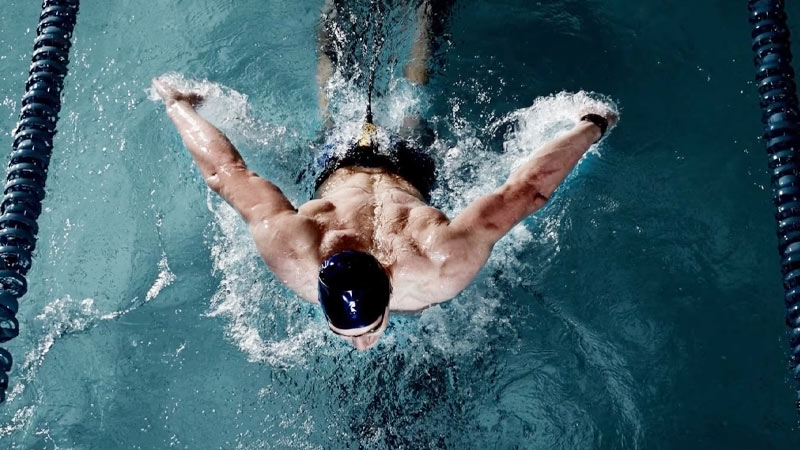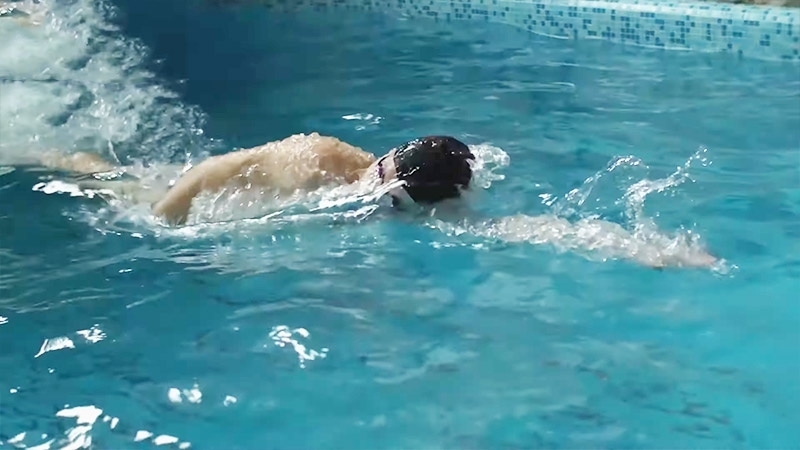When it comes to full-body workouts, swimming often takes the lead as a refreshing and invigorating exercise. But beyond its cardiovascular benefits and muscle toning, have you ever wondered how swimming impacts your core muscles?
In our blog post, we dive deep into the world of aquatic fitness to explore ‘is swimming cardio’ and how effective swimming is at strengthening your core.
Swimming engages various muscle groups, including those in your abdomen, lower back, and hips, making it a holistic workout that goes beyond simply keeping you afloat.
From the freestyle stroke’s rhythmic twists to the powerful undulations of the butterfly stroke, each movement challenges your core in unique ways.
We will also explore the science behind swimming’s core benefits, the best strokes for targeting your midsection, and practical tips to maximize your core workout in the water. Stay focused.
What Is Core Muscle?
Core muscles refer to the group of muscles located in the torso, encompassing the abdomen, lower back, pelvis, and hips. These muscles play a crucial role in stabilizing the spine, supporting posture, and facilitating various movements.
Key core muscles include the rectus abdominis (front), obliques (side), transverse abdominis (deep), and erector spinae (lower back). Strengthening the core is essential for overall stability and can help prevent back pain, improve balance, and enhance athletic performance.
Core exercises, such as planks, bridges, and twists, are commonly used to target and develop these muscles, promoting better functional fitness and reducing the risk of injury.
Is Swimming Good For Core Muscles?
Swimming is an excellent workout for strengthening core muscles. The dynamic movements involved in swimming engage the entire core, including the abdominal, lower back, and oblique muscles.
As you swim, your core muscles work to stabilize your body in the water, support efficient strokes, and maintain proper body alignment. This continuous engagement not only enhances core strength but also improves posture and balance.
Additionally, swimming is a low-impact exercise, reducing the risk of injury to the joints while providing a full-body workout. Regular swimming can contribute to a strong and toned core, making it a highly beneficial activity for overall fitness and core muscle development.
How Swimming Benefits Core Muscles
Swimming offers several key benefits for core muscles:
Full-body engagement
Swimming engages the entire body, requiring core muscles to work continuously to stabilize and control movements in the water. This engagement helps develop core strength and endurance.
Balance and posture
Swimming promotes improved posture and balance by encouraging a streamlined body position in the water. Core muscles play a crucial role in maintaining this alignment, leading to better posture both in and out of the pool.
Resistance training
Water provides natural resistance, making swimming an effective resistance exercise. Core muscles work harder against the water’s resistance, helping to tone and strengthen them over time.
Range of motion
Swimming involves a variety of strokes and movements, which challenge core muscles in different ways. This diverse range of motion helps develop core flexibility and overall functional fitness.
Low-impact exercise
Swimming is gentle on the joints, reducing the risk of injury compared to high-impact activities. This makes it accessible to people of all ages and fitness levels.
Cardiovascular benefits
Swimming is also an excellent cardiovascular workout, increasing heart rate and improving circulation. This overall fitness enhancement complements the core muscle development achieved through swimming.
Incorporating swimming into your fitness routine can help you build a strong, stable, and well-toned core while providing numerous other health benefits.
Swimming for Rehabilitation and Injury Prevention

Swimming is a valuable activity for both rehabilitation and injury prevention due to its unique properties:
Rehabilitation
Low-Impact Exercise
Swimming is gentle on the joints, making it an ideal choice for individuals recovering from injuries or surgeries. It minimizes the risk of further damage while providing a means to regain strength and mobility.
Range of Motion
The wide range of motion involved in swimming helps improve joint flexibility and muscle mobility, aiding in rehabilitation after injuries or surgeries that may limit movement.
Muscle Strengthening
Swimming engages multiple muscle groups, including the core, without putting excessive strain on specific body parts. This can assist in rebuilding muscle strength after injury.
Cardiovascular Health
Swimming offers cardiovascular benefits, promoting overall fitness and enhancing circulation, which can be especially helpful during recovery periods.
Injury Prevention
Full-Body Workout
Swimming is a holistic exercise that works for various muscle groups simultaneously, promoting balanced muscle development and reducing the risk of muscle imbalances that can lead to injuries.
Improved Flexibility
Swimming’s dynamic movements encourage flexibility, reducing the likelihood of muscle strains and joint injuries.
Enhanced Core Strength
A strong core, developed through swimming, contributes to better posture and stability, reducing the risk of injuries related to poor body mechanics.
Stress Reduction
Swimming can alleviate stress and tension, which, when left unchecked, can contribute to injuries. It provides a mentally soothing environment for physical activity.
Weight Management
Swimming supports weight management, reducing the strain on joints and decreasing the likelihood of obesity-related injuries.
Swimming offers a low-impact, full-body workout that aids in rehabilitation and helps prevent injuries by improving overall fitness, flexibility, and strength.
Tips for Maximizing Core Benefits in Swimming
To maximize the core benefits of swimming, consider the following tips:
Focus on Proper Technique
Correct swimming technique is essential. Enroll in lessons or work with a coach to ensure you’re using the right strokes and body movements. Proper technique engages your core effectively.
Engage Your Core
Pay attention to your core muscles while swimming. Consciously tighten and engage your abdominal muscles as you move through the water. This helps strengthen your core more effectively.
Vary Your Strokes
Different swimming strokes engage the core muscles differently. Incorporate a variety of strokes like freestyle, backstroke, breaststroke, and butterfly to target all areas of your core.
Use Kickboards and Pull Buoys
These swimming aids can isolate and intensify core engagement. For example, using a kickboard for kicking exercises or a pull buoy for upper body work can help focus on strengthening the core.
Interval Training
Incorporate interval training into your swim routine. Swim at a higher intensity for short bursts, then recover at a slower pace. Interval training can enhance core strength and overall fitness.
Incorporate Drills
Include specific core-focused drills in your workouts. For instance, do scissor kicks or flutter kicks to intensify core engagement and build strength.
Bilateral Breathing
Practicing bilateral breathing (breathing on both sides while swimming) can help balance your core muscles, as it requires you to alternate your body position during each breath.
Warm-Up and Cool Down
Always warm up before your swim and cool down afterward. Incorporate gentle stretches to maintain flexibility and prevent muscle stiffness.
Consistency is Key
Regular swimming sessions are essential for building and maintaining core strength. Aim for a consistent swimming schedule to see significant improvements in your core muscles over time.
Cross-Training
Complement your swimming routine with other core-strengthening exercises like yoga, Pilates, or resistance training to further enhance your core strength and stability.
Stay Hydrated and Eat Well
Proper hydration and a balanced diet are crucial for muscle recovery and overall performance. Ensure you’re fueling your body adequately.
Listen to Your Body
If you feel pain or discomfort during swimming, stop and assess your form. Pushing through pain can lead to injury. Consult a coach or physiotherapist if necessary.
By implementing these tips and maintaining a consistent swimming regimen with a focus on core engagement, you can maximize the core benefits of swimming while also enjoying improved overall fitness and well-being.
Best Swimming Stroke for Abs
The best swimming stroke for targeting and strengthening the abdominal muscles (abs) is the butterfly stroke. Here’s why:
Intensive Core Engagement
The butterfly stroke requires powerful undulating movements of the torso, which demand significant core strength and engagement. This stroke engages both the upper and lower abdominal muscles, making it highly effective for overall ab development.
Full-Body Workout
Butterfly also engages the chest, shoulders, and lower back muscles, providing a comprehensive upper body and core workout.
Continuous Motion
Butterfly involves a fluid, continuous motion that challenges your core muscles throughout the entire stroke cycle. This sustained engagement is excellent for building endurance and core strength.
However, it’s worth noting that the butterfly stroke is one of the most technically demanding swimming strokes and can be physically demanding. It may not be suitable for beginners or individuals with certain physical limitations.
If you’re new to swimming or have concerns about your ability to perform the butterfly stroke, consider seeking guidance from a swim coach or instructor.
FAQs
Is swimming good for health?
Swimming is excellent for health. It provides a full-body workout, improves cardiovascular fitness, strengthens muscles, enhances flexibility, and is easy on the joints. Swimming also helps reduce stress and promotes overall well-being.
How often should I swim to see improvements in my core muscles?
For noticeable results, aim to swim regularly, at least 2-3 times a week. Consistency is key to building and maintaining core strength. Start with shorter sessions and gradually increase the duration as your endurance improves.
Can swimming help alleviate lower back pain and improve posture?
Yes, swimming can help with lower back pain and posture. The gentle, low-impact nature of swimming reduces strain on the lower back, while the engagement of core muscles improves spinal stability, reducing the risk of back issues and enhancing posture.
Is there a specific swimming stroke that targets core muscles better?
The butterfly stroke is particularly effective for core muscle development. Its undulating movements engage both upper and lower abdominal muscles, offering an intensive core workout. However, incorporating various strokes like freestyle and backstroke provides a balanced approach to core strengthening.
Can swimming alone give me a well-defined six-pack?
While swimming can contribute to a strong core, achieving a well-defined six-pack also depends on factors like diet and genetics.
Core exercises on dry land can complement your swimming routine for more focused abdominal muscle definition. Remember that overall fitness is essential for a toned midsection.
Wrapping Up
In the world of fitness, swimming stands as a versatile and enjoyable option that not only improves cardiovascular health but also strengthens your core muscles.
As we’ve explored in this article, swimming engages your abdominal, lower back, and oblique muscles through a variety of strokes, making it an effective and low-impact way to achieve a strong and stable midsection.
Whether you’re a competitive swimmer or a casual enthusiast, the benefits of swimming for your core muscles are undeniable.
So, take the plunge, make a splash, and let swimming become your go-to workout for a toned and resilient core. Remember, consistency is key, so dive in regularly and enjoy the myriad benefits of this aquatic fitness adventure! Best of luck.







